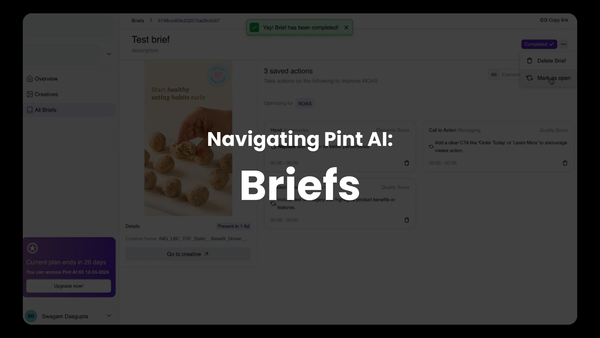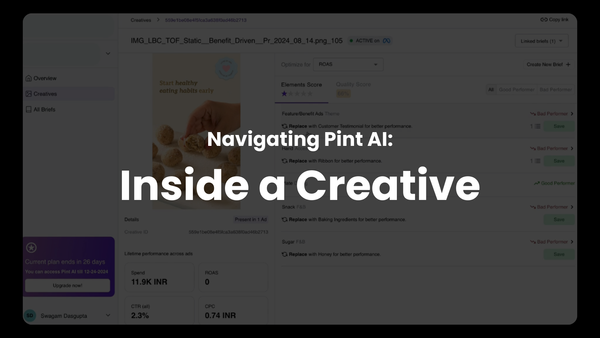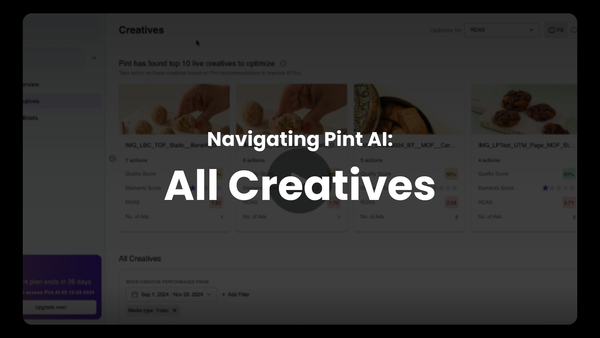Creative Analytics: A Crucial Cog in the Growth Marketing Machine
By integrating creative analytics into the growth marketing process, businesses can make more informed decisions, optimize their strategies more effectively, and ultimately drive better business outcomes.

It's obvious that in this day and age, businesses need to be agile, data-driven, and innovative to stay ahead of the competition. Two disciplines that have emerged as critical components of this approach are growth marketing and creative analytics.
While each has its distinct focus, their synergy can significantly enhance a company's marketing effectiveness and drive sustainable growth. This post delves into the connection between growth marketing and creative analytics, highlighting how their integration can lead to better marketing outcomes.
Understanding Growth Marketing
Growth marketing is a holistic, data-driven approach that focuses on the entire customer lifecycle, aiming to achieve sustainable and scalable growth.
Unlike traditional marketing, which often emphasizes top-of-the-funnel activities such as brand awareness and lead generation, growth marketing covers all stages of the customer journey and employs various strategies and tactics to optimize each stage for maximum growth.

Key components of growth marketing include:
- Data and Analytics: Growth marketing relies on data to make informed decisions, involving constant measurement and analysis of performance metrics. A/B testing and experimentation are crucial to finding the most effective strategies.
- Full-Funnel Focus: Growth marketing addresses the entire marketing funnel: acquisition, activation, retention, referral, and revenue (AARRR model). This holistic approach ensures that prospects and existing customers are nurtured at every stage.
- Cross-Disciplinary Collaboration: Successful growth marketing involves collaboration with different teams, including product development, sales, and customer success. This fosters a culture of shared goals and collective success.
- Customer-Centric Approach: Understanding customer needs and behaviors is paramount. Growth marketers prioritize delivering personalized and relevant experiences throughout the customer journey.
- Agility and Iteration: Growth marketing emphasizes rapid testing and iteration, allowing marketers to quickly learn what works and adapt to changing market conditions and customer preferences.
Defining Creative Analytics
Creative analytics is the process of using data to measure and analyze the performance of creative elements such as images, videos, and copy in marketing campaigns. This discipline involves tracking how different creatives impact engagement, conversion rates, and overall campaign effectiveness.
Key aspects of creative analytics include:
- Performance Measurement: Creative analytics measures the impact of individual creative elements on various metrics such as engagement, click-through rates, and conversions. This helps marketers understand which creatives resonate best with their audience.
- Optimization and Iteration: Based on performance data, creative analytics allows marketers to iterate on and optimize their creatives. This involves testing different variations to find the most effective ones.
- Personalization and Segmentation: Creative analytics provides insights into how different audience segments respond to various creative elements. This enables marketers to deliver personalized content that is more likely to engage and convert.
- Cross-Channel Insights: Creative analytics tracks the performance of creatives across different channels, helping marketers understand where their creatives perform best and why.
Tools like Pint AI specialize in this.

The Link Between Growth Marketing and Creative Analytics
The synergy between growth marketing and creative analytics is evident in several key areas.
By integrating creative analytics into the growth marketing process, businesses can make more informed decisions, optimize their strategies more effectively, and ultimately drive better business outcomes.
Creative analytics is a cog that you can fit into the growth marketing machine. Here’s how these two disciplines are connected:
Data-Driven Decision Making
- Growth Marketing: Relies on data to identify what works and what doesn't across the customer lifecycle.
- Creative Analytics: Analyzes creative elements to determine their effectiveness in engaging and converting audiences.
- Link: Creative analytics provides the granular data on which creative assets are performing best, enabling growth marketers to optimize their campaigns based on these insights.
Optimization and Iteration
- Growth Marketing: Involves continuous testing, learning, and optimizing strategies and tactics.
- Creative Analytics: Involves analyzing performance data of creative elements and iterating to improve them.
- Link: Insights from creative analytics fuel the iterative process in growth marketing, helping refine creative assets to boost overall campaign performance.
Personalization and Segmentation
- Growth Marketing: Aims to deliver personalized experiences to different customer segments.
- Creative Analytics: Provides data on how different segments respond to various creative elements.
- Link: By understanding segment-specific creative performance, growth marketers can tailor their messages and creatives to better resonate with each target audience.
Cross-Channel Insights
- Growth Marketing: Looks at the performance across multiple marketing channels to optimize the entire customer journey.
- Creative Analytics: Tracks and compares the performance of creatives across different channels (e.g., social media, email, display ads).
- Link: Cross-channel creative performance insights help growth marketers allocate resources to the most effective channels and creatives.
Customer Journey Optimization
- Growth Marketing: Focuses on optimizing every stage of the customer journey (AARRR: Acquisition, Activation, Retention, Referral, Revenue).
- Creative Analytics: Helps identify which creatives are most effective at different stages of the customer journey.
- Link: By aligning creative performance data with the customer journey stages, growth marketers can deploy the most impactful creatives at the right time.
Performance Measurement
- Growth Marketing: Measures success through various KPIs such as CAC, LTV, churn rate, and conversion rates.
- Creative Analytics: Measures the impact of individual creative elements on engagement, conversion rates, and other metrics.
- Link: Creative analytics provides detailed performance metrics that feed into the broader KPIs used in growth marketing, offering a comprehensive view of what drives success.

Practical Applications of the Synergy
Campaign Optimization
Growth marketers use creative analytics to identify high-performing creatives and allocate more budget to them while discontinuing or improving underperforming ones.
For example, a growth marketing team running a multi-channel campaign uses creative analytics to find that a particular video ad has higher engagement on social media. They then increase the spend on this ad and create similar content for other channels.
A/B Testing
Creative analytics can identify which variations of creative elements perform best, providing insights for growth marketers to conduct more effective A/B tests.
For example, analyzing different headline variations in email campaigns to see which one leads to higher open and click-through rates, then using the winning headline in future campaigns.
Personalized Marketing
Growth marketers leverage creative analytics to deliver personalized content based on user preferences and behaviors.
For instance, using data to show that a certain demographic prefers visual content over text, growth marketers can create more visually-driven campaigns for that segment.
ROI Analysis
Both growth marketing and creative analytics focus on maximizing return on investment by identifying the most cost-effective strategies and creatives.
For example, calculating the ROI of different creative assets and reallocating budget to the highest-performing ones to maximize overall campaign profitability.
Conclusion
The integration of growth marketing and creative analytics represents a powerful approach to achieving sustainable business growth. By leveraging data and insights from creative analytics, growth marketers can make more informed decisions, optimize their strategies, and deliver personalized experiences that resonate with their target audience.
This synergy enables businesses to stay agile, adapt to changing market conditions, and ultimately drive better marketing outcomes. Embracing this integrated approach can lead to significant improvements in marketing effectiveness and long-term business success.





